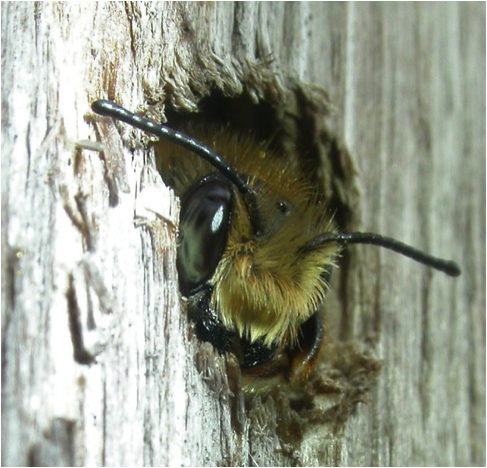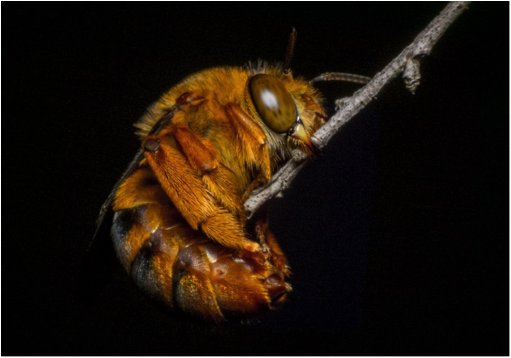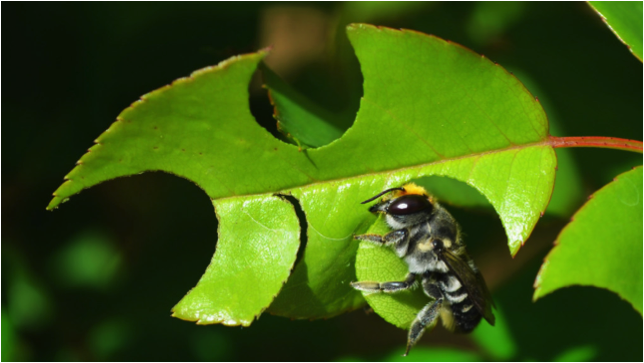Do bees sleep? Where do they live in the winter?
As part of Garden to Garden, we take a look at the wonderful – and often hidden – world of bees.
______________________________________________________________________________
Bees live up to their busy reputation if you take the time to watch them. Moving from flower to flower with focus, they definitely look like insects that have got stuff to do. But we recently began to wonder: what do they do when they’re not pollinating?
Bees are extraordinarily productive. Along with other pollinators, bees work wonders for us humans – individual bees often visit over 1000 flowers a day. Although only a few species produce the honey that humans, bears and other foraging animals love to eat, bees keep the plant world alive by pollinating flowers which allows the plants to reproduce. Over a third of the world’s food supply depends on insect pollination – without bees, we would seriously struggle.
Invisible Dust’s new downloadable insect guide – Ento-Sleuthing – has information about the history of our ancient relationship with bees as well as a toolkit for identifying those that you see out and about on the flower. This blogpost will look at some of the things that bees do when they’re not pollinating and out of sight – what bees do when they’re not at work.

A female solitary bee emerging from her nest: Source
Most bees aren’t the social sort you might imagine. The vast majority of species don’t live in colonies and hives with different roles for queens, drones, workers like honey bees and bumble bees do. The UK has over 250 species of bee: 25 bumble bees, 1 honey bee and all the rest are solitary bees.
Solitary bees nest on their own and don’t produce honey or wax. Different solitary species vary greatly in size, in appearance and in where they choose to nest. Many of them are impressive pollinators: a single red mason bee pollinates as much as 120 worker honeybees. So even though they aren’t producing honey, all of the time they spend pollinating flowers keeps our ecosystems alive.
Do bees sleep at night?
Bees rest and sleep at night. Which might seem obvious, but it wasn’t studied scientifically until the 1980s when a researcher called Walter Kaiser observed their sleep-wake cycles and found that honeybees sleep an average of five to seven hours a night.
Walter Kaiser’s research was the first detailed study to show that invertebrates sleep just like mammals, and although we still don’t know very much at all about why animals sleep, we know that virtually all of them do.
A sleeping bee’s antennae will stop, their head and tail tucks in and the wings rest on their body, like in the picture below. Female solitary bees sleep in their nests but male solitary bees sleep outside, resting in places like grass stalks or in flowers.

A sleeping teddy bear bee: Source
Nesting
Whereas colonies of honeybees and bumble bees build nests together, female solitary bees do it alone, and the places where they choose to do so are as varied as the species themselves.
Some bees make their nests in holes in walls, plant stalks or cliff faces. Mining bees burrow into the ground and make their nests there. The two-coloured mason bee nests in empty snail shells.
The Willoughby’s leafcutter bee is often found in gardens and urban environments in the UK. Like other leafcutter beers, they build their nests in holes or cavities and then use circular leaf cuttings to make individual cells for their eggs to develop in.
Rather than leaves, Mason bees build cells using mud or other bits of masonry after finding a suitable hole.
Building nests and storing food for their eggs takes a great deal of work though and isn’t much of a break.

A leaf cutter bee
Seasons
Most bees have annual life cycles: they are born, reproduce and die within a year. In some species that live in colonies, the queen survives the winter after the rest of the bees have huddled round to preserve warmth. But most solitary bees don’t live through the winter and the females die off after laying their eggs in the individual cells in their burrows.
Before the cold weather arrives, the females spend time filling each of the individual cells with pollen and bee butter. Once they hatch and begin to develop the next year, her young offspring eat their way through their supplies before they emerge with the warmer spring weather.
Like other plants and animals, bees respond to weather cues such as temperature changes in spring. This means that the changing climate and weather patterns risk disrupting the normal plant and bee pollination cycles.
Threats to bees
Whether in a local garden, wild flower meadow or crop field, bees are usually a good sign of a thriving environment. Many species in the UK and worldwide are currently threatened due to climate change and a range of other factors.
The use of insecticides in contemporary intensive farming has contributed to the rapid decline in populations of pollinators observed around the world in recent decades. In 2018, one of the most widely used types of insecticides (Neonicotinoids) were banned across the European Union though it is still in use elsewhere.
Bees also suffer from pests and diseases, and there are a number of viruses which have spread around the UK and across the world.
High-intensity farming also results in the loss of bees’ habitats such as hedgerows, flower meadows and grasslands – 95% of the UK’s wildflower meadow land has been lost since the 1940s.
Today, land management and farming methods play critical roles in the protection and creation of habitats and the future of bee populations.
Giving bees a break
If you want to support bees there are ways you can help. Friends of the Earth has a petition that you can sign to the Environment Secretary to ask that the UK commits to the reduction of pesticide use. You can help scientists understand the current state of bees and other pollinating insects by recording sightings at home or in your local area.
You can also use any outside space – from a window box to a large garden – to encourage bees to your local area by planting herbs and flowers, providing sources of water or even building a bee hotel. Find out more here.
The Waggle Dance
Finally, there is the famous waggle dance, which is still part of a bee’s work but more than worthy of a mention.
It’s a complicated dance that honey bee workers do to tell others in the colony where they can find food. By waggling at a particular angle for a particular length of time, a bee is able to communicate to her friends the distance to the food and its direction in relation to the sun. It means that bees are the only other animals aside from us that can communicate a message abouts something’s location without needing to leave a physical trail. David Attenborough explains it here.
Find Out More
Invisible Dust’s downloadable ‘Ento-Sleuthing’ pack has more information on insect identifying and Scarborough’s South Cliff Gardens
Friends of the Earth’s Bee Cause has more information, resources and ways you can support bees.
The 17 minute documentary The Solitary Bees by Team Candiru was filmed in the UK and has footage of young bees feeding on pollen left by their mother.
National Geographic has a 60 second time-lapse on YouTube of honey bees hatching from eggs.